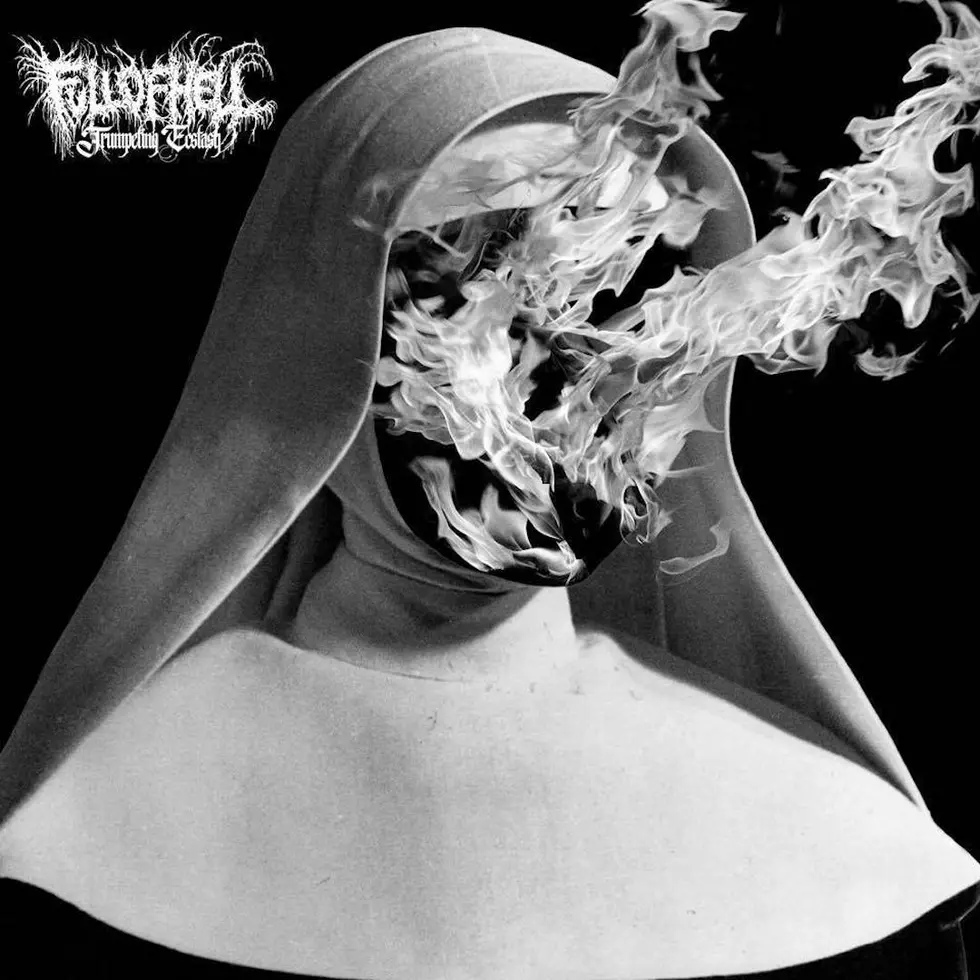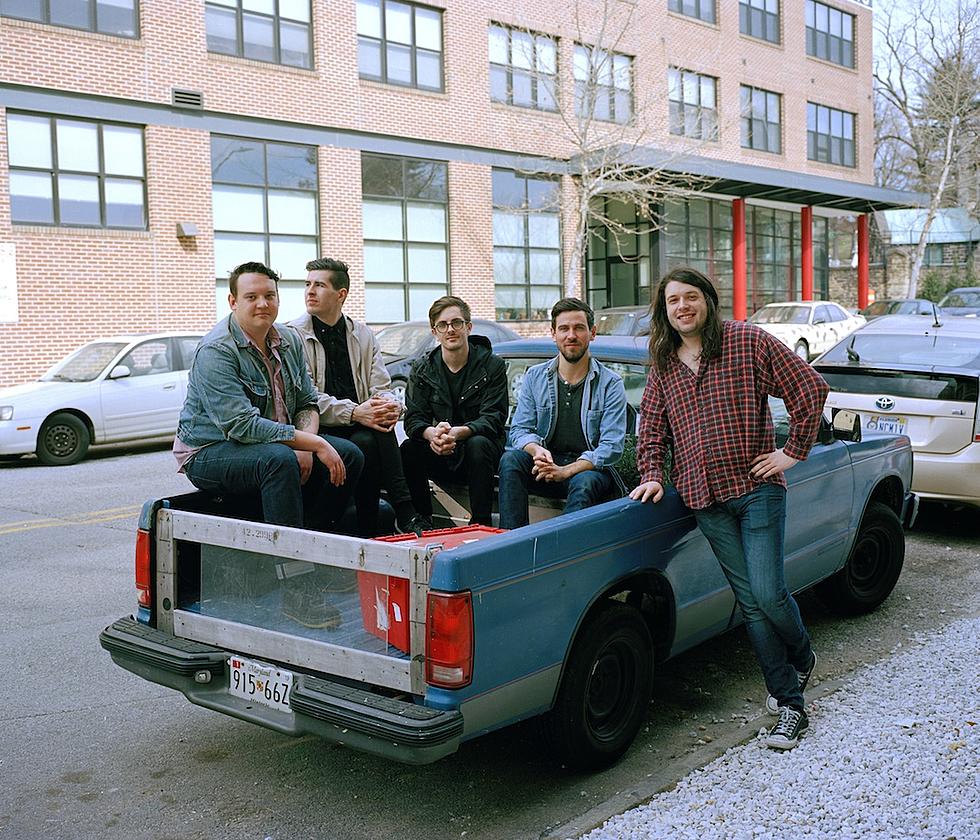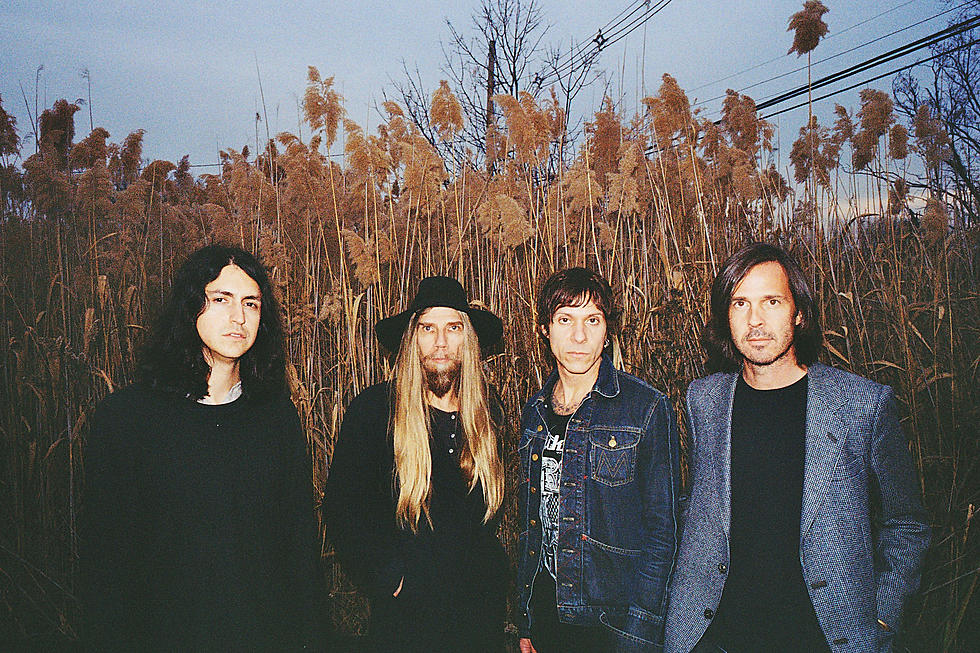
Full of Hell Fulfill All Promises With Best LP Yet
Verify it if you must, but it's been four years since Full of Hell released an album. Sure, the band has done collaborative work with the Body and Merzbow, and splits with Code Orange, Psywarfare and Nails, but they haven't sat down and created their own record since 2013's Rudiments of Mutilation. Yet Full of Hell has never stopped touring — be it around the globe, with friends in Thou or the Body, or playing with legends of metal and hardcore ranging from G.I.S.M. to Immolation. Full of Hell can and will not stop. And now the years of hard touring, recording and grinding away are paying off with Trumpeting Ecstasy.
Trumpeting Ecstasy is the band's debut LP for Profound Lore (the label previously released their collaborative effort with Merzbow), and it feels like years of sleeping on floors, truck stop dinners and siphoning gas coming to one brutal culmination. Mixing in death metal influences with grind, hardcore, powerviolence, noise and industrial, the new Kurt-Ballou-produced LP feels like the band's endgame all along: a mix of extreme styles that never feels contrived and always feels furious. Stream the band's latest single, "Crawling Back to God," below for the first time, and order yours via Profound Lore before it hits on May 5.
Vocalist Dylan Walker does not grant many interviews, but he agreed to sit down with CLRVYNT to discuss the new LP, collaborating versus flying on their own, and where the hate comes from. The results of our conversation are below.
The LP starts out with a quote from Werner Herzog that basically discusses the chaos of the jungle. Why did you start the LP like this? Do you see parallels between man and beast?
When I watched that particular scene, Herzog is so dissatisfied with nature and the natural world. He’s sort of disgusted by it and hostile toward it. We just thought it would be a fitting parallel to open the record with: the world at war against you and with itself. In a certain light, it’s sort of vile and base and awful. It felt like a perfect mood-setter.
Do you watch a lot of film in your off time?
Yes, definitely. Lately it’s someone like Ben Wheatley, who did Kill List. We actually have a couple samples from A Field in England on the record — tiny lines. Those films are so cold and strange and pretty brutal. Gaspar Noé, of course, is a big influence. Awful portraits of humanity.
The term Trumpeting Ecstasy is really striking, but a cursory search on Google does not bring anything. Where does it come from?
In my area of Pennsylvania, there are a lot of old wooden signs that have scripture on them … foreboding Old Testament-style scripture. And it always makes me scoff. There is one near my house, and I really love it. It’s an old sign with a trumpet, and underneath it says, “Perhaps tomorrow,” as in, “The Rapture might come tomorrow … where will you be?” I just love the iconography of that trumpet sounding during the Rapture. Certain words strike you, and "ecstasy" struck me. I just imagined that joyous feeling if the Rapture actually came.
After a few listens to Trumpeting Ecstasy, it seems as if this is the record that you’ve been working toward all along. Do you think it’s just experience or working with Kurt Ballou this time out that got you to this place?
For the close-to-a-decade that we’ve been a band, our writing style hasn’t really changed, but our musicianship has gotten better and better and better over the years. I think that growing together and writing and doing all of these collaborations have been very beneficial. When we finally came back to our little bubble, it was so exciting that it was pretty easy to push it out. We hadn’t done anything like that in a bit. I can’t discount Kurt at all, though; he was awesome to work with. He didn’t really have a producer role — more of a someone who would make suggestions and critiques, nudging us in a direction along the way. Little ideas here and there.
You’ve done a lot of collaborative work, whether recorded or live. Do you think that having to compromise — even considering that you are pretty like-minded with those bands — makes you a better musician when you came back to home base?
Absolutely. One-hundredfold, actually. And it’s several different situations, too, since working with Merzbow meant Masami [Akita] was in Japan; and the Body, we spent months and months together. When [the collaboration with] Merzbow came out, a lot of people really liked it, and some people had valid criticism of it. As young musicians, that was hard, but you learn to grow and accept it. Then we worked with the Body, in the same room, and those guys are geniuses. They are so unconventional, so we had to learn from them and work with them. And the way that the Body writes records is so alien … very improvisational, maybe even from the jazz school of thought. Whereas we are the type to rehearse and get everything to an exact point. Every interaction we’ve had with them has been fortunate for us. We’re very fortunate to call them friends — they’re so talented. It changed everything, working with those guys.
It shows a level of maturity that you can let go of ego and do a real collaborative effort. And then do it again.
It’s less about ego for us. Masami is our hero, and the Body is my favorite contemporary band. Honestly, we would have followed in their footsteps regardless, but fortunately, we worked together. Definitely no ego involved.
The artwork comes from Mark McCoy, who is famous in underground circles for everything from Charles Bronson to his label Youth Attack. Tell me a little bit about McCoy, his art and why you feel like he was the right choice for this record.
I think that Mark is an aesthetic genius. I was always into his bands growing up, a huge nerd for all that stuff. So, it’s really inspiring that he did all these bands that were hugely important to me growing up and even now; his art is very dead-on and hits me in the right spot to this day. I love all of it. I think his artwork is super striking and original, and it’s something we strive for … it’s just there and it says so much. Whether it’s the photography-based stuff, or collages, or illustration … he’s a really inspiring artist. He really nailed it.
Everyone borrows from someone for inspiration, and I feel like where you guys sit is somewhere in between classic Earache and the works of Neanderthal / Man Is the Bastard / Bastard Noise. Obviously, you're making your own blueprint from this, but you're definitely putting this style of music in front of kids who probably wouldn’t have any connection to it otherwise — like 1349 fans or Entombed fans or hardcore fans.
I agree, definitely, but I think there are later inspirations, too. Like, the Endless Blockade is a modern band that were hugely influential to us. It’s been a matter of minutes since they’ve been a band, but they were a big influence to us.
Every band likes to think they are 100 percent unique, but we certainly borrow vibes and motifs and playing styles from across the board. Like that OG West Coast powerviolence stuff. The Earache era. As time goes on, we are definitely becoming more intrigued with death metal. Deicide, South American shit … absolutely love Sarcófago. But I think that it’s probably accurate that you can pull from lots of different influences in our music.
Do you like being the odd man out on shows like these, though? How does it feel to play shows like that?
It’s exciting. I don’t think about it too much nowadays. I think that playing This Is Hardcore is an excellent example, because we are always the weird band on the bill, bar none. We used to antagonize by saying, “We should play 10 minutes of noise at the end,” or something to that effect, but now its more like, “Let's just play as hard as we can.” Even these metal tours, like Immolation … the traditional metalhead fan usually doesn’t know what to do with us. Their fans are looking for them.
Getting back to collaboration, you didn’t entirely avoid that idea, as you have some pretty killer names on the new LP. How did these collaborations with Nicole Dollanganger and Nate Newton and others come about?
Well, the guest spots for the record came together just by chance. We’re pretty fortunate. With Nicole, who is sort of the most interesting collaboration, she is sort of into heavy bands. We found out about that because she was on Grimes' label, and I thought it was so wild that she was into heavy stuff. It kind of blew my mind. Her music is so beautiful — truly angelic. We thought it would be cool to build a sort of industrial-type track, so Lee Buford provided the beat and Nicole just rips over top of it.
Andrew Nolan from the Endless Blockade, he sings on the record. He’s been sort of a big brother / mentor type since day one, and it turned out amazing. Nate Newton’s collaboration was huge for me, too, because Neurosis and Converge are two of my most important influences. Kurt Ballou is on the record, too. Not a lot of intelligent design … just sort of happenstance.
Aaron Turner guests on the new track. How do you think his work — from Hydra Head to Isis, even up until now with SUMAC and Old Man Gloom — has impacted you, Full of Hell and heavy music in general?
When I was in high school, finding Hydra Head was like an epiphany. I think I found the label through a grapevine that started with LimeWire (downloading Daughters and Discordance Axis tracks one by one) and ended with the discovery of what seemed like every avenue of traditional extreme music, but more provoking and challenging. I think I actually first discovered Merzbow via Hydra Head, even. It felt like the perfect label, basically. Every sonic extreme I'd come to love, plus ones I didn't even know existed as a young teenager. When we first got Full of Hell going, I remember having a late-night van discussion about aspirations for the band, and Spencer [Hazard, guitar] and I related about how, in the perfect end, we'd be a Hydra Head band. It was just a huge inspiration from day one. Aaron's music specifically has such scope and depth, as well. Having him sing on the track is affirming in a really positive way. It's wild to us.
More From CLRVYNT









